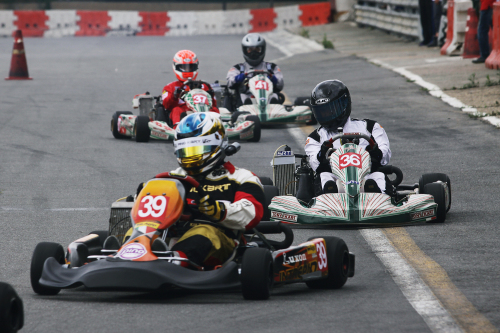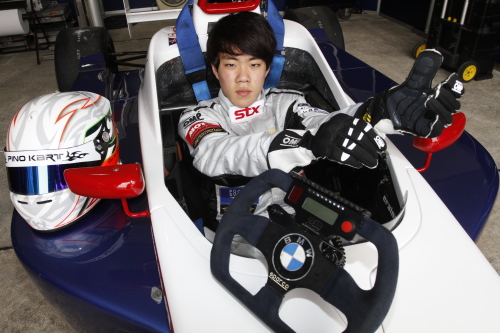Experience the thrill of racing with kart driving
It’s a blisteringly hot afternoon in July, and we are standing on the asphalt track, wearing heavy racing suits and helmets, perspiring as if we just ran a full-marathon.
We are, in fact, just looking down at a tiny four-wheel car, commonly known as a go-kart, in which we’d be cruising around on the track in for the next four hours.
This whole idea of getting hands-on kart driving experience came up when a group of sports correspondents gathered in Yeongam, South Jeolla Province to attend a special ceremony at the Yeongam International Circuit, marking 100 days to the Korean F1 Grand Prix in October.
 |
Kart racing at the Paju Speedpark in Gyeonggi Province (GP Korea) |
A member of the group suggested that kart racing is a must-try for all who are into motor sports to gain a better understanding of racing.
So here we are, this time at the Paju Speedpark in Gyeonggi Province, to give go-karting a try.
Before sitting behind the wheel, we are advised to wear protective gear, including a fire-proof racing suit, and also given a safety instruction.
“Don’t underestimate this little fellow,” said Kim Tae-eun, the owner of speedpark, who first introduced kart racing here nearly ten years ago.
Don’t compare it to a bumper car ride at amusement parks or ordinary rental karts: driving a racing kart is a completely different thing, says Kim.
This miniature-size racing car weighs just over 80 kilograms, but is equipped with hi-tech 125cc engine, which can propel a man at up to 150 kph, he explains.
The 1.2-kiometer circuit at the Paju Speedpark features a 250-meter straight line, where one can drive at full speed, and more than 10 different corners and turns, which simulate a real F1 racing circuit.
In order to drive a racing kart, one must learn racing techniques and strategies, Kim says. Today, we are lucky to have a very well-qualified teacher ― Seo Joo-won, the reigning Korean kart champion ― as the instructor for the day.
The 17-year-old has been go-karting for just over three years, but has won numerous titles and became the 2010 season champion.
“The first time I went go-karting with my parents, I just loved it. And now it’s my job,” Seo says, before starting his kart.
The teenage driver, who doesn’t even have a driving license, shows us his racing skills, making a quick run at the circuit: He was looking fairly calm and didn’t seem to make any effort while driving through the corners and turns.
“This is a lot harder than it looks. You need to have absolute control over the car and racing skills to drive smoothly like him,” Kim explains.
 |
Seo Joo-won, Korean kart racing champion (GP Korea) |
Now it’s our turn. But before starting our car, Seo gives us a brief lecture.
One of the first and foremost driving skills, he says, is a “slow-in and fast-out.”
Many immature drivers tend to brake way too late and carry too much speed into the corners, but if one brakes too hard in a turn, it greatly increases the braking distance and increases the chances of spinning the wheels, he explains.
“Also, if you accelerate while turning, your wheels will be likely to spin. You need to finish your break before entering a corner, and as soon as you see the end of the corner you floor the gas pedal to quickly get out,” he adds.
“Is it dangerous?” I wonder out loud before putting my helmet.
“Kart driving is not dangerous. No one has ever gone upside down here,” Kim says.
“Slow in, fast out,” keeping the piece of advice in mind, I push the kart to start the engine and jump inside ― I had to make a couple of runs to actually nail it down.
The first corner was no problem, maybe because my kart was too slow. But at the second corner, I forgot to slow it down and braked suddenly, only to spin the wheels and stall the car.
Kim gives a pep talk about not worrying about spinning or damaging the kart, so I give it my best shot ― only to spin out, fly off the track and slide on to the grass before stalling the car. It is clear that I’m not a natural-born driver.
“Don’t be too hard on yourself. You need at least two years to be a racing kart driver,” Kim says.
Despite some frustration with the corners the experience, on the whole, is great fun. In particular, when you run down the straight line at full speed, sitting on a piece of metal only just a couple of centimeters off the ground, it feels almost as if you were driving a Formula One car at 300kph. Also, if you make a quick turn at the corners, you can experience a glimpse of G-force, the greatest pressure that F1 drivers have to cope with.
To go racing, you don’t need a driving license, but you need to be fit, says Seo. He is right. By the third round, partly because of the tensions during the drive, my arms, shoulders and neck are already in pain, and after four hours of driving I could barely lift my arms.
My very first kart racing trial soon opens my eyes to the fact that these are certainly not toys for children. Kart racing, in fact, provides the perfect apprenticeship for young drivers considering a professional career in motorsports, Kim says.
One can learn essential driving skills, how to deal with strict safety rules, and also experience rigorous practice sessions, qualification heats and finals, according to Kim.
However, he admits that its value is still unknown due to the lack of popularity of the sport. Kim claims that there is almost no support in developing kart racing here.
“Many now understand it is important to develop youth programs to nurture more talented footballers. But they still don’t recognize the importance of kart racing,” he says with a sigh. But hopefully, things will change, he says, as last year Korea hosted its first F1 Grand Prix, and is contracted to continue until 2016.
“We need more support to develop kart racing, so that we can produce a Korean F1 driver,” he says.
Seo, who is currently leading the country’s only kart championships, says he now feels it’s time for him to progress from karting to car racing ― like many Formula One drivers, including Michael Schumacher, Jensen Button and Lewis Hamilton at the beginning of their careers. Seo says he is planning to compete in Formula BMW from next season.
“I’m confident, and I really want to be the first Korean F1 driver. That is my dream.”
Where to go:
Paju Speedpark is located approximately one hour drive from central Seoul. Rental karts are hired for 10 minutes for 18,000 won. You can also have a full-day package, which includes a one-on-one lesson, for 150,000 won.
A driver’s license is not necessary but you do need to take a pre-lesson if you want to try a racing kart. For more information, visit www.pspark.co.kr or call (031) 959-0420.
By Oh Kyu-wook (
596story@heraldcorp.com)









